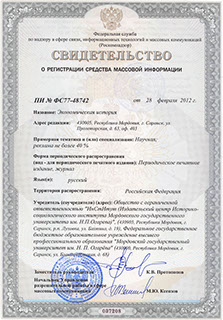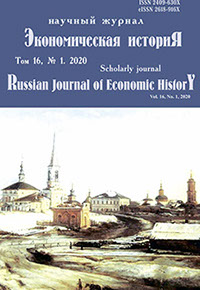Экономическая историЯ
Russian Journal of Economic History
ISSN 2409-630X (Print)
ISSN 2618-916X (Online)
Expert board:
- Scientific Council of RAS on economic history;
- Research and Educational Center «The economic history of Central Russia and the Middle Volga region» of Ogarev Mordovia State University;
- Center of Economic History of Lomonosov Moscow State University
Navigation
Certificate of registration

ISSN 2409-630X (Print), ISSN 2618-916X (Online)
DOI: 10.15507/2409-630X.048.016.202001.009-019
Alexander V. Akimov
Institute of Oriental Studies, the Russian Academy of Science (Moscow, Russia),
е-mail: akimovivran@mail.ru
NEW PRODUCTIVE FORCES: TECHNOLOGIES AND SOCIETY
Introduction. The article deals with innovations in technology in recent years, which significantly affect the prospects of socio-economic development. Methods. The article uses the historical method, description of technologies and forecast scenarios. Results. The productive forces of any society consist of three components. These are natural resources, human labour and capital, or tools and technologies. During the first three technological revolutions, the role of human labor in the reproduction processes in the economy changed, but was consistently high. In the course of the fourth industrial revolution, technologies are being created to replace human labor in production. Together with the labour-saving technologies accumulated during the previous industrial revolutions, they dramatically increase the role of capital and technology and displace man and women from material production and a large part of the service sector. Discussion and Conclusion. Society’s adaptation to new technologies can be realized in different scenarios. The variety of options for socio-economic and political development can be reduced to four main options with the following conditional names: “New Rome”, “Communism according to K. Marx”, “Dystopia”, “Cheap labour in the service sector”. The first is an analogue of the ancient Roman social structure with robots working instead of slaves. The second is the Communist distribution model with material abundance. The third is the crude power of elite with varying degrees of genocide against their own people. The fourth is the maintenance of market relations in the sphere of services for employment of the population, while goods will be produced by robotic systems and artificial intelligence.
Keywords: technologies, industrial revolutions, a new system of productive forces, robotics, artificial intelligence, man in the production system, scenarios of interaction of society with new technologies.
For citation: Akimov A. V. New Productive Forces: Technologies and Society. Ekonomicheskaya istoriya = Russian Journal of Economic History. 2020; 16(1): 9–19. (In Russ.). DOI: 10.15507/2409-630X.048.016.202001.009-019.
© Ogarev Mordovia State University. History and Sociology Institute, 2017
68, Of. 411, Bolshevistskaya St., 430005, The editorial office of the scholarly journal «Russian Journal of Economic History»
Tel.: (8342) 24-25-90; 27-07-11, Fax: (8342) 24-25-90, E-mail: jurnal-econom-hist@isi.mrsu.ru
Designed by A. Napalkov, Email: napalkov@isi.mrsu.ru

